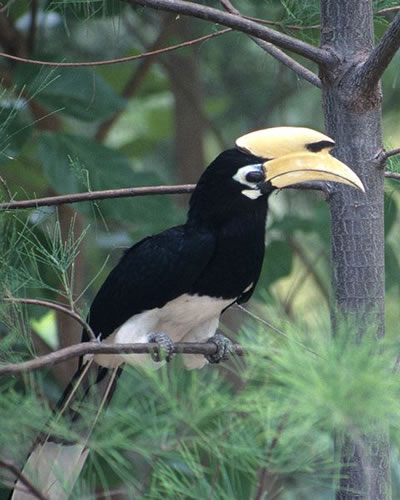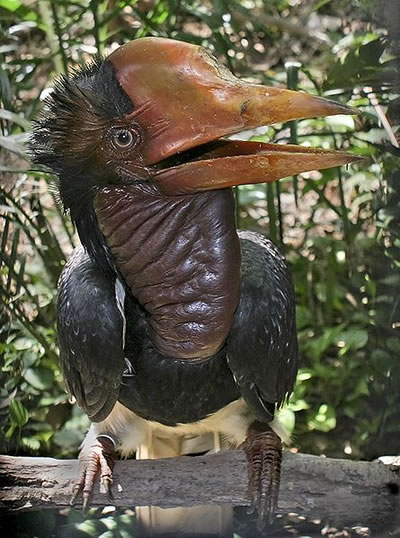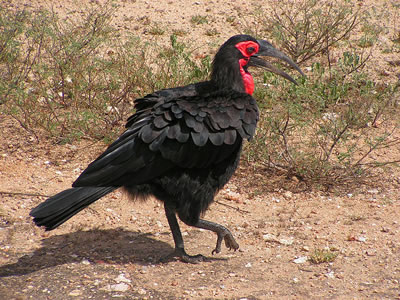Hornbills

Facts about creatures
- Home
- Animal Classification
- Animal Habitats
- Amphibians
- Arthropods
- Bats
- Birds
- Carnivorans
- Cetaceans
- Chordates
- Crustaceans
- Dinosaurs
- Diprotodonts
- Elephants
- Fish
- Golden Mole
- Insects
- Lagomorphs
- Mammals
- Mammal Teeth
- Marsupial Mole
- Metamorphosis
- Mollusks
- Primates
- Reptiles
- Rodents
- Ruminants
- Soricomorphans
- Tenrec
- Tetrapods
- Vertebrates
Hornbills
Hornbills belong to the family Bucerotidae.
They live in southern Africa, tropical Asia and the South Pacific.
Hornbills have long, heavy bills that turn downwards.
These bills are often brightly colored.
A hornbill has strong neck muscles that help support its bill.
In addition, the first two vertebrae of a hornbill’s neck are fused together. This provides even more support for the bill.

A hornbill has a structure on the top of its bill that is known as a casque. It is usually hollow or filled with spongy material.
The casque is made of keratin, a protein that is also found in hair and nails.
In some birds, the casque is very large and is used to amplify calls.
Some male hornbills use their casques to batter one another during mating displays. They ram their casques into each other while in mid-air.
The helmeted hornbill (Rhinoplax vigil), which lives in Borneo, Sumatra and the Malay Peninsula, has a heavy casque that contains a material known as hornbill ivory, or golden jade, which is considered to be very valuable and is used for making carved ornaments.
Helmeted hornbills are hunted for their hornbill ivory.
Hornbills are large birds. They vary in size from between about one foot to about four feet long.
They usually have black, brown, grey and white feathers.
Long modified feathers near a hornbill’s eyes make it look like it has eyelashes.
The kidneys of hornbills have only two lobes. Other birds have three-lobed kidneys.
While hornbills usually live in forests, some species live in grassland – in savannahs and steppes.
Hornbills tend to spend most of their time in trees, but two species of African hornbills known as ground hornbills – the Abyssinian ground hornbill (Bucorvus abyssinicus), also known as the northern ground hornbill, and the southern ground hornbill (Bucorvus leadbeateri)- are usually found on the ground.
A hornbill’s diet consists of fruits, insects and small birds and mammals; hornbills are omnivorous.


When hornbills eat fruit, they swallow the seeds. They may fly for long distances before defecating, releasing the seeds. This helps to ensure that when new plants grow, the plants are dispersed over a wide area.
Hornbills are sometimes kept as pets.
People sometimes hunt hornbills for food.
Some hornbill species that live in tropical rainforests are threatened with extinction as their habitat is being destroyed.
Hunting by humans has also greatly reduced the hornbill population.
Hornbill Nest
Hornbills are monogamous.
They build their nests in holes in trees and cliffs.
After the female lays her eggs, she will seal up part of the entrance to the nest with mud, leaving a space just big enough for her to pass through. Once she is inside, she will cement herself in with feces that hardens it as it dries.
When she is done, she will leave only a tiny space that is just large enough for the male to pass food to her and her young.
Sometimes the male will help her by sealing her in with mud from the outside while she works from the inside.
By cementing the nest this way, the parents help to protect the eggs and the young from predators.
Sometimes other hornbills will help the male feed his mate and his children. This is an example of cooperative breeding, in which individuals care for the young of other individuals.
The female will stay in the nest for up to four months, molting and growing a new set of light feathers while she is sealed up inside.
Sometimes, she female will break out of the nest while the chicks are still growing so she can help the male to feed them.